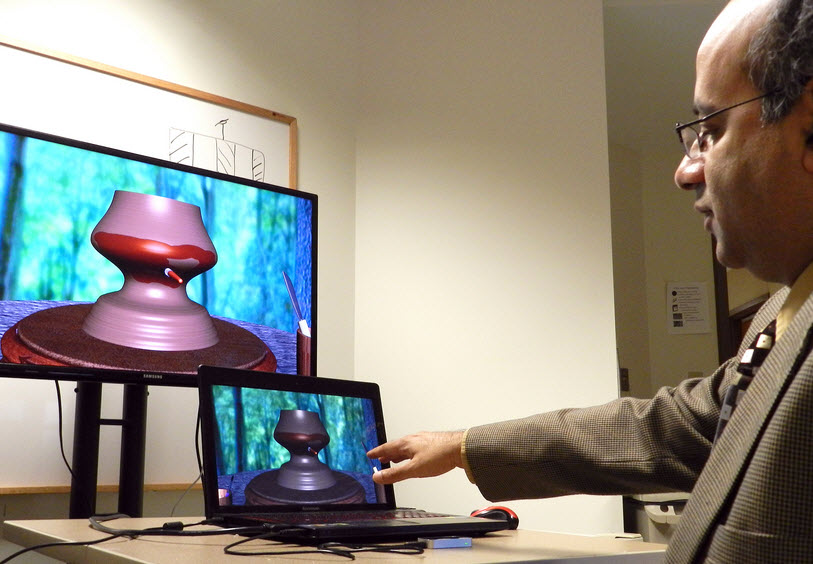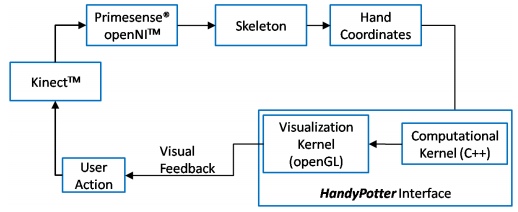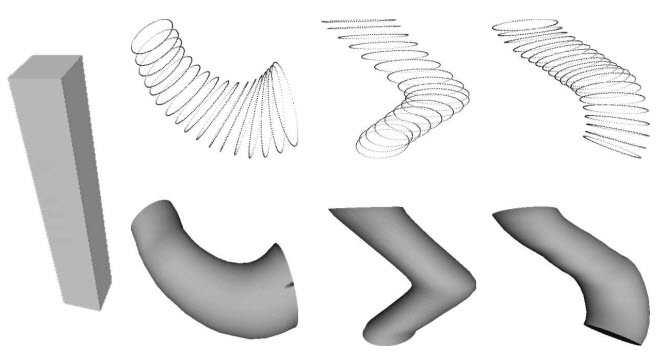Purdue spinoff commercializes new design tool that helps users create computer-generated shapes without using a mouse
February 17, 2015

Karthik Ramani, Purdue University’s Donald W. Feddersen Professor of Mechanical Engineering and co-founder and chief scientist of Zero UI, demonstrates how the Handy Potter can be used as a hand-free, gesture-based 3D modeling software to create digital models and then print the designs on a 3D printer (credit: Purdue Research Foundation)
A Purdue innovation that enables people to use a new class of hands-free, gesture-based 3D modeling software is being commercialized by Zero UI, a Cupertino, California-based company that specializes in 3D modeling technology.
The technology, called Handy-Potter, addresses the complexity and limitations of conventional computer-aided-design (CAD) tools used to create geometric shapes.
Handy-Potter uses a Kinectdepth-sensing camera with advanced software algorithms to interpret hand movements and gestures.
Easy to use
“This technology is very simple and easy for users, but behind that simplicity are complicated and intelligent algorithms that represent a state-of-the-art synthesis of machine learning and geometric modeling,” Ramani said.
The technology could have applications in the areas of games, architecture, art, and engineering design. It was developed in the laboratory of Karthik Ramani, Purdue University’s Donald W. Feddersen Professor of Mechanical Engineering and co-founder and chief scientist of Zero UI.
“This technology is very simple and easy for users, but behind that simplicity are complicated and intelligent algorithms that represent a state-of-the-art synthesis of machine learning and geometric modeling,” Ramani said.

Pipeline showing the flow of information from the user to the Handy-Potter system and back (credit: Purdue Research Foundation)
“The technology could change the way people interact with the computer. This tool allows people to express their ideas rapidly and quickly using hand motions alone. We want to make it a natural action for people to gesture to a computer screen and create things with their hands.”

Fully constrained, partially constrained and free-form generalized cylinders using Handy-Potter (credit: Vinayak et al./ASME)
Zero UI founder and CEO Raja Jasti said Handy Potter is designed to help anyone create digital models such as drums, tables, lamps, and other objects on a computer and then print the designs on a 3D printer.
“You don’t have to be an architect or an engineer to use this software,” he said.
The research was funded in part by the National Science Foundation.
Purdue Research Foundation | Zero UI
Abstract for Handy-Potter: Rapid 3d shape exploration through natural hand motions
We present the paradigm of natural and exploratory shape modeling by introducing novel 3D interactions for creating, modifying and manipulating 3D shapes using arms and hands. Though current design tools provide complex modeling functionalities, they remain non-intuitive and require significant training since they segregate 3D shapes into hierarchical 2D inputs, thus binding the user to stringent procedural steps and making modifications cumbersome. In addition the designer knows what to design when they go to CAD systems and the creative exploration in design is lost. We present a shape creation paradigm as an exploration of creative imagination and externalization of shapes, particularly in the early phases of design. We integrate the capability of humans to express 3D shapes via hand-arm motions with traditional sweep surface representation to demonstrate rapid exploration of a rich variety of fairly complex 3D shapes. We track the skeleton of users using the depth data provided by low cost depth sensing camera (KinectTM*). Our modeling tool is configurable to provide a variety of implicit constraints for shape symmetry and resolution based on the position, orientation and speed of the arms. Intuitive strategies for coarse and fine shape modifications are also proposed. We conclusively demonstrate the creation of a wide variety of product concepts and show an average modeling time of a only few seconds while retaining the intuitiveness of communicating the design intent.
* Not used in the version of the system shown in video. — Editor